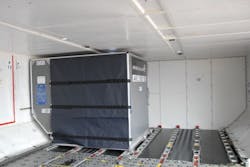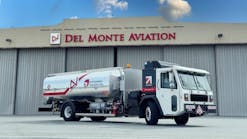Everyone taking a flight on an aircraft would expect their seat to be firmly attached to the cabin floor and their seat belt be available to secure them in the seat, the same exact situation holds true for baggage and cargo, ULD is the “seat” - think about what is happening during turbulence, maybe you fasten your seat belt and grab hold of your glass to make sure your drink does not spill, but just a few inches below your feet many tonnes of cargo is actually only staying in place because of the job done by the ULD.
There are two components to what ULD do, the first can be described as “ULD Operation,” this is when the loaded ULD is placed on board the aircraft and is performing its function of cargo restraint, the second component can be described as “ULD Handling," and this is basically anything and everything that gets the ULD and its load into the aircraft; it includes storage, transport, movement around the cargo terminal and build up to name just some aspects.
Clearly without suitable handling there is no chance that a ULD will be able to operate correctly, yet sad to say a short walk around many aircraft loading bays will uncover containers, pallets and cargo nets, built up and just awaiting loading into the aircraft, or even worse having just been offloaded from the aircraft, with damages that are beyond allowed limits, and a longer walk will most likely turn up poorly stored ULD, poor quality dollies and extensive use of forklifts to move ULD in the cargo sheds.
Furthermore if one wishes to dig deeper than just anecdotal visual evidence one needs look no further than two IATA safety databases which collect information from a wide range of airlines:
Data from the IATA STEADES database (http://www.iata.org/services/statistics/gadm/steades/Pages/index.aspx) indicates that industry-wide 16 unsafe loading conditions occur on a daily basis, a proportion of these are documentation errors on load sheets but a substantial number also apply to ULD that are not in a condition to operate correctly. Furthermore the same database indicates that the majority of these unsafe events are only discovered on the arrival of the flight rather than being caught before departure!
Data from the IATA Ground Damage Database (http://www.iata.org/services/statistics/gadm/Pages/GDDB.aspx) places ULD in the No. 1 position for damage to aircraft! Further analysis of this data shows that almost all the reports are for damage to the interior of the cargo holds and are caused by ULD that are out of contour or otherwise not in the correct condition being loaded rather than rejected ship side. Maybe these events are not as spectacular as a loader hitting an engine or wing flap, but the sheer number of reports indicates a widespread practice of “anything goes as long as the flight leaves on time”!
How has this situation come to pass? When airlines first started to outsource their ground handling and cargo terminal operations to independent service providers ULD operations went along for the ride. What was never clearly defined and understood by everyone was that a ULD, when positioned in the aircraft prior to takeoff must be in compliance with the aircraft Weight and Balance Manual (WBM) a document that is just as important as the flight operations manual or maintenance manual. During a presentation on ULD operations at the recent IATA groundhandling conference the audience, comprising mainly of ground handers, was asked for a show of hands if they were aware of the existence of WBM, less than 10 percent could raise their hand, and when asked the further question of whether they had ever read the ULD requirements in detail perhaps 2 percent had done so.
How does this play out? Three lines summaries the situation:
- An improperly handled ULD will probably be damaged
- A damaged ULD may very well no longer be airworthy
- A non airworthy ULD may not be loaded onto the aircraft
Is this so hard to understand? Not really, but the bigger question is how to embed a culture of respect for ULD into the global handling environment? Since 2010 IATA has undertaken a great deal of work to create a greater awareness of the importance of satisfactory ULD operations, as to be sustainable the airline industry needs to be assured that only safe and airworthy ULD are making it onto their aircraft and secondly they need protection against the ever increasing cost of repairing damaged ULD and damaged aircraft as well as disruption to flights which is estimated to be in the order of $400 million a year.
And it is not just the airlines who are thinking about this, in the aftermath of two fatal crashes involving mis-loaded cargo, Fine Air in 1997 and National Air Cargo in 2013 the U.S. Federal Aviation Administration (FAA) has taken a very close look at cargo operations and in response to their findings have issued extensive guidelines as to how U.S. airlines are expected to carry out their cargo operations. The latest version of the Advisory Circular AC 120-85A may be downloaded from http://www.faa.gov/regulations_policies/advisory_circulars/index.cfm/go/document.information/documentID/1027808 and is recommended reading for anybody managing any part of the process of loading cargo to aircraft. Of special relevance to the ground handling and cargo industry are the multiple references to vendors, a term used by the FAA to define non airline third parties, and emphasis is placed on the necessity that vendor employees have undergone satisfactory levels of training.
Is it so unreasonable to ask the operators who are loading hundreds of tonnes of cargo into ULD every day have been properly trained? After all when we take a flight we would expect that the flight crew are trained, the cabin crew are trained, the mechanics are trained, the air traffic controllers are trained, so where is the logic that says that the people loading the cargo into ULD which will in turn be loaded into the aircraft do not require similar levels of training? Is the job so simple or is it that the industry does not feel these people are worthy of training or is it just a matter of let's hope we can get away without spending any money on training for a bit more time?
In the time it has taken you to read this article numerous ULD around the world have been handled or mishandled, have been operated in an airworthy or non-airworthy condition. Is this a sustainable situation or are we just one step away from the next cargo restraint related accident, not to mention the continued waste of money repairing unnecessarily damaged ULD?
This is the first of two articles on the subject, in next month's edition we will dig deeper into the underlying problems that impact ULD, and explore the available solutions for the industry, meanwhile we could recommend visiting: http://www.iata.org/whatwedo/cargo/unit-load-devices/Pages/index.aspx and http://www.uldcare.com.






